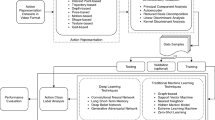Abstract
Video surveillance is an integrated system with strong prevention capabilities and widely used in military, customs, police, fire fighting, airports, railways, urban transport and many other public places. It’s an important part of security system because of its visualized, accurate, timely and rich information content. Video surveillance has become the main tool due to its rich, intuitive and accurate information. However, with the large-scale construction of video surveillance systems all over the world, problems such as “useful information and clues cannot be found immediately with video big data” decrease detecting efficiency during crime prediction and public security governance. The increasing need of video based applications issues the importance of parsing and organizing the content in videos. However, the accurate understanding and managing video contents at the semantic level is still insufficient. The semantic gap between low level features and high level semantics cannot be bridged by manual or semi-automatic methods. In this paper, a semantic based model named video structural description (VSD) for representing and organizing the content in videos is introduced firstly. Video structural description aims at parsing video content into the text information, which uses spatiotemporal segmentation, feature selection, object recognition, and semantic web technology. The applications of VSD technology on public security from surveillance videos are given. The intelligent analysis of person and vehicle from surveillance video based on VSD is presented. The cloud enhanced platform managing surveillance videos is also given. At last, applications using VSD are introduced.











Similar content being viewed by others
Notes
The largest city in China with about 23 million people.
References
Berners-Lee T, Hendler J, Lassila O (2001) The semantic Web. Sci Am 284(5):34–43
Chen H and Ahuja N (2012) Exploiting nonlocal spatiotemporal structure for video segmentation. 2012 I.E. Conference on Computer Vision and Pattern Recognition, pp.741-748
Choi M, Torralba A, Willsky A (2012) A Tree-based context model for object recognition. IEEE Trans Pattern Anal Mach Intell 34(2):240–252
Deng J, Dong W, Socher R, Li LJ, Li K, and Fei-Fei L (2009) ImageNet: A large-scale hierarchical image database. In CVPR
Felzenszwalb P, Girshick R, McAllester D, and Ramanan D (2010) Object Detection with Discriminatively Trained Part-Based Models. In PAMI
Hu C, Zheng Xu, et al. Video Structured Description Technology for the New Generation Video Surveillance System. Frontiers of Computer Science, 10.1007/s11704-015-3482-x
Javed K, Babri H, Saeed M (2012) Feature selection based on class-dependent densities for high-dimensional binary data. IEEE Trans Knowl Data Eng 24(3):465–477
Krizhevsky A, Sutskever I, and Hinton GE (2012) Imagenet classification with deep convolutional neural networks. In Advances in neural information processing systems, 1097–1105
Li W, Zhao R, Xiao T, and Wang X (2014) Deepreid: Deep filter pairing neural network for person re-identification. In CVPR
Liu Y, Zhang Q, Lionel MN (2010) Opportunity-based topology control in wireless sensor networks. IEEE Trans Parallel Distrib Syst 21(3):405–416
Liu Y, Zhu Y, Ni LM, Xue G (2011) A reliability-oriented transmission service in wireless sensor networks. IEEE Trans Parallel Distrib Syst 22(12):2100–2107
Luo X, Zheng X, Yu J, Chen X (2011) Building association link network for semantic link on Web resources. IEEE Trans Autom Sci Eng 8(3):482–494
Ma Y, Wang L et al (2013) Distributed data structure templates for data-intensive remote sensing application. Concurrency Compu Prac Experience 25(12):1784–1797
Plebani P, Pernici B (2009) URBE: Web service retrieval based on similarity evaluation. IEEE Trans Knowl Data Eng 21(11):1629–1642
Russakovsky O, Deng J, Su H, et al (2014) ImageNet Large Scale Visual Recognition Challenge. arXiv:1409.0575, http://image-net.org/challenges/LSVRC/.
Simonyan K and Zisserman A (2014) “Very deep convolutional networks for large-scale image recognition”. arXiv preprint arXiv:1409.1556
Wang L, Tao J et al (2013) G-Hadoop: MapReduce across distributed data centers for data-intensive computing. Futur Gener Comput Syst 29(3):739–750
Wigan M, Clarke R (2013) Big data’s big unintended consequences. Computer 46(6):46–53
Xu Z, Luo X, Wang L (2011) Incremental building association link network. Comput Syst Sci Eng 26(3):153–162
Xu Z et al (2015) Semantic based representing and organizing surveillance big data using video structural description technology. J Syst Softw 102:217–225
Zhuge H (2009) Communities and emerging semantics in semantic link network: discovery and learning. IEEE Trans Knowl Data Eng 21(6):785–799
Acknowledgment
This work was supported in part by the National Science and Technology Major Project under Grant 2013ZX01033002-003, in part by the National High Technology Research and Development Program of China (863 Program) under Grant 2013AA014601, in part by the National Science Foundation of China under Grant 61300202, in part by the China Postdoctoral Science Foundation under Grant 2014 M560085, and in part by the Science Foundation of Shanghai under Grant 13ZR1452900,
Author information
Authors and Affiliations
Corresponding author
Rights and permissions
About this article
Cite this article
Xu, Z., Hu, C. & Mei, L. Video structured description technology based intelligence analysis of surveillance videos for public security applications. Multimed Tools Appl 75, 12155–12172 (2016). https://doi.org/10.1007/s11042-015-3112-5
Received:
Revised:
Accepted:
Published:
Issue Date:
DOI: https://doi.org/10.1007/s11042-015-3112-5




